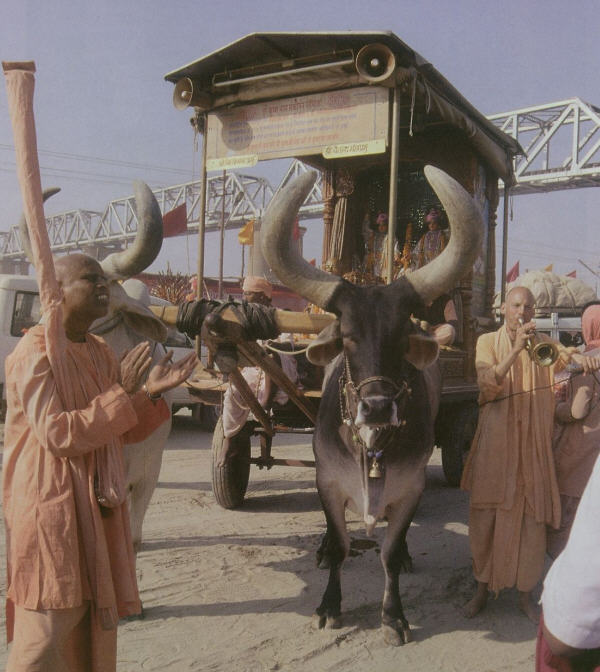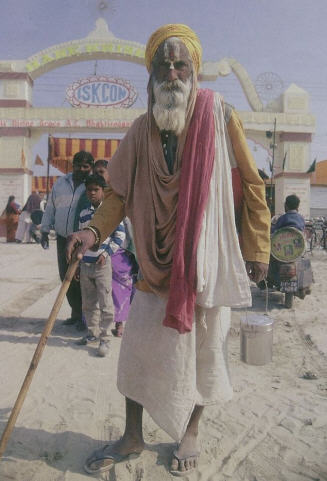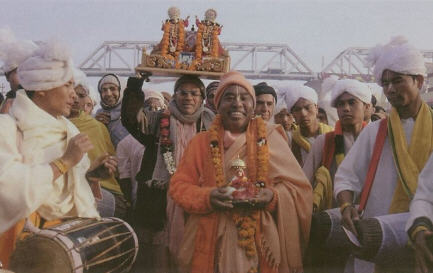The sights, sounds, smells, and spirit of
the world's largest religious gathering.
MY HUSBAND, Krsna Prema Dasa, and I are on our second pilgrimage to Kumbha-mela, having come here in 1989. Our excitement rises as we reach the edge of the vast encampment. The air is hazy with fog, dust, and campfire smoke. The Indian government has erected numerous pontoon bridges spanning the mighty Ganges River. As the Tata Sumo we're riding in drives over a bridge into the city of tents, we feel we've entered a place untouched by time.

Everything looks and feels much the same as it did when we came here twelve years ago, and will probably look the same twelve years from now. Pilgrims arrive in families with great bundles on their heads. Sadhus dressed in saffron carry sticks or tridents. Some have mountains of matted hair piled on their heads. Some (known as Naga Babas) are naked.
Camps have erected front gates, ranging from simple bamboo frames to huge, elaborate entrances that resemble palaces or temples. Every camp has several loud-speaker horns blaring music, drama, or discourse. Government loudspeakers, placed on poles every ten meters, compete for attention with news, music, discussions, or announcements. All this goes on constantly. The sounds and music mingle and crash together to make such a menagerie of sound that I wonder how anyone can understand any of it.
We finally enter Sankaracharya Marg, the main road, where the ISKCON camp lies. Its white gate sports three arches. "Hare Krishna" is written at the top, ISKCON is written on a central lotus, and the red words "Founder-Acarya A. C. Bhaktivedanta Swami Prabhupada" span the three arches.
The three-acre camp sits near a huge brick support for a train bridge that spans the Ganges and sandy plain. A thirty-meter-high "HARE KRISHNA" sign over the camp can be seen from anywhere in the entire Kumbha-mela.
Hopping out of our Tata Sumo, we enter the camp and quickly make our way to the reception tent, eager to settle in and head out for a photographic overview.
I'm soon donning my photo-vest and filling it will film and lenses. As Krsna Prema pulls out his video gear, we hear the loud beating of drums and head for the central area of the camp. Bhakti Svarupa Damodara Swami has come from Manipur with his "100 Drums" troupe. They dance gracefully while beating out intricate rhythms. I wiggle my way through the crowd to get a good vantage point for photos, the turbaned drummers spinning and leaping through the air while pounding the wooden drums.
As the drum exhibition ends, we ease our way out onto the streets of the Kumbha-mela. The Shastri Bridge provides a good vantage point, so we head toward it.
Pilgrims and loudspeakers release a continuous river of prayers and mantras. Allahabad was previously known as Prayag, "place of sacrifice." Holy men are meant to perform sacrifice and penance here to benefit human society by reawakening and renewing spiritual values. I see devotees of different orders everywhere. The various colored devotional markings on their foreheads add to the tapestry of Kumbha-mela.
By the time we reach Shastri Bridge, the sun is hovering low on the horizon. The vast tent city spreads as far as we can see. As we cross the bridge, the golden sun reflects softly on the Ganges as it converges with the Yamuna. Lights flicker in the twilight as mist from the rivers thickens with campfire smoke.
We finish our photo session in near darkness. As we make our way back to camp in time for the evening meal, my eyes sting from the smoke of a thousand campfires.
January 14
Mangala-arati (early-morning wor-ship) takes place in the center of the compound in front of the ornate ISKCON Padayatra bullock cart, which bears deities. Padayatra, a walking festival that travels from village, began in 1984 and has walked around India four times since.

I walk out onto the streets of the Mela. It is still dark and slightly foggy. Thousands of colored lights adorn the vast encampment. Exotic smells of incense and spices drift through the vibrant morning air. I photograph illumined gates up and down one of the main roads.
Thousands of pilgrims move about through the mist. Lights twinkle and flash on and off in patterns. Smiles and curious eyes are everywhere. Mantras mix with announcements. Today is one of the important days for immersion in the confluence of the three holy rivers: the Ganges, the Yamuna, and the subterranean Sarasvati. Bathing at this holy time and place and associating with saintly persons purify sinful reaction, opening the heart to spiritual understanding, liberating one from repeated birth and death.
Back at our camp, everyone prepares for a procession to the confluence. Our procession consists of the "100 Drums" from Manipur, a large blue banner declaring that we are ISKCON, small deities of Lord Caitan-ya and Lord Nityananda, and a small brass icon of Srila Prabhupada.
We chant and dance spontaneously through the streets. The drummers beat out a strong rhythm that can be heard at a great distance, clearing the way and attracting onlookers. As we near a pontoon bridge, we get stuck in a mass of pilgrims. We push on until we're jammed in tight, going nowhere.
Bursting out from the mass of humanity, I find myself on the edge of a parade of yogis and pilgrims returning from their holy dip. Unlike my last visit, this year the Naga Babas seem indifferent to photographers. I happily snap away as hundreds of ash-covered naked or loincloth-clad Naga Babas leap and bound off the pontoon bridge, waving swords and tridents and calling out to Lord Siva.
When I hear Krsna Prema shout that our procession is moving, I join, and we soon enter the bathing arena. Pilgrims are everywhere. As we near the water, Krsna Prema and I spot a raised vantage point that allows us to see the expansive confluence of the rivers glistening in the late-morning sun. Bathers everywhere chant and sing with exuberance. Within eleven hours, ten million people will immerse themselves in the water. It is simply amazing that so many can gather in peace and respect solely to come closer to spiritual perfection. In some densely populated Western cities, a violent crime occurs every twenty seconds. Six weeks of Kumbha-mela produced no violent crimes.
After taking photos, we near the water, but because we're so laden with equipment, we just sprinkle water on our heads, knowing that this simple act will somehow uplift and energizing our souls.
We return to our camp, and I hobble with blistered feet past twelve dioramas depicting philosophical concepts and the Lord's pastimes and incarnations. Devotees stand at each diorama, ready to answer questions.
Three booths selling Srila Prabhupada's books are quite busy. A half-naked yogi with trident in hand and matted hair piled on his head inspects and then buys a book.
I enter a large tent decorated with chandeliers. Onstage, dramas, dance recitals, and philosophical discourses run morning to night. When the programs end, pilgrims sleep there. Some generous ISKCON members have donated blankets and jackets to the poor sadhus.
January 15
After breakfast we walk three kilometers to take a closer look at the confluence of the rivers. The crowd is much thinner than yesterday, making it easier to navigate the sandy streets of the Mela.

An impromptu market occasionally comes into view rows of merchants sitting on the ground, their wares spread out before them or on a cart. Items for sale range from fruit and vegetables to bangles, bobbles, and water jugs (to bring home Ganges water to friends and relatives).
As we reach the embankment leading down to the river, the Ganges and Yamuna glisten in the sun. Boats ply to the center of the confluence. Birds rise and fall, silhouetted against the river water. Pilgrims of all ages are everywhere some in the water, some preparing to go in, some drying off, some offering prayers, and some carrying brass pots of the prized confluence water.
On the way back to camp, we spot the daily ISKCON chanting party. Two beautiful oxen from Gujarat pull the carved wooden Padayatra cart. Standing tall with huge horns curving over their heads, they look stately and majestic, undisturbed by the chanting and dancing that surrounds them.
The streets of the Kumbha-mela resound with Hare Krsna. Devotees know that chanting the holy name of the Lord is the perfection of yoga. Small elderly ladies and loincloth-clad yogis join the chanting. The nectar of immortality flows freely in the form of the holy name.
January 16
After waking up with a cold and a sore throat, I spend the morning lying in the winter sun, chanting and listening to the sounds of the Mela.
Later I decide to watch the abundant prasadam distribution at the ISKCON camp. The gates open at 11:00 A.M. Ordinary pilgrims stand in line for hours, but sadhus have a special line. Donors sponsor five thousand hot-and-tasty meals a day. Thirty devotees from Vrndavana cook over wood-pit fires, using enormous pots. I feel awed by their dedication.
Surely Srila Prabhupada is pleased with the ISKCON camp. The devotees seem to be doing everything right. The daily chanting party, the public tent program, the question-and-answer booth, and the prasadam distribution all run smoothly. More than fifteen hundred books are sold daily to the ten thousand daily visitors. A mood of helping pervades the camp, reflecting the spirit of the Mela.
Nitya-trpta Devi Dasi, a photographer, and her husband Krsna Prema Dasa, a musician, created Krsna Vision, a multi-slide-projector presentation. Now they're moving more into the digital realm, developing multimedia interactive CDs and computer presentations.
